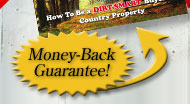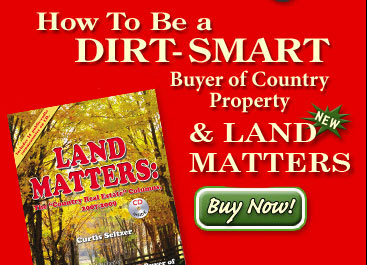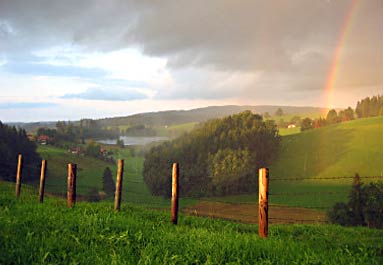



|

With timberland, think longer term
By Curtis Seltzer
If I had to point to one factor that led to both the stock-market decline and the real-estate collapse last year, it would be the desire of both individuals and institutions to grab short-term profits. Economists who study financial bubbles always seem to find short-term thinking underlying these phony booms.
The desire of individuals to try to enrich themselves fast is both universal and not readily modified. I’m no different than the next guy. In small and scattered doses, a large system is not deranged by such behavior; in a large concentration, greed wrecks itself.
Small timberland investors have for many years played both sides of this street; me, too. They wanted the merch timber on their newly purchased property to pay it off to the maximum extent possible and then they wanted to call the cutover a “second-home lot” or a recreational property and sell it for more than they had bought it for.
When timberland could be bought at a timberland price with a significant amount of merchantable timber, the merchantable trees could be cut immediately, or soon after purchase, and the income used to pay down (or even off) the land’s mortgage. The timber-sale income was protected from immediate federal income tax to the extent that the timber basis at the time of acquisition matched sale income. With the debt down, the investor could hold his timberland or sell it -- in whole or in parts -- whenever he chose. The more merch timber could pay for timberland acquisition, the more profit could be made, both short- and long-term.
During the last 15 years and especially during the last 10, timberland prices have been pushed up by a factor of two, three and even four as landowners reclassified these properties as second-home lots and recreational tracts. Everyone wanted to get in on the no-work, price-appreciation magic that came from simply calling 100 acres of woods a second-home “woodette.”
The problem with everyone rushing into this exit is that it has virtually eliminated the older model of timberland investing. Small timberland buyers have had trouble finding property with merchantable timber at investment prices. A lot of this inventory is sitting very still, priced at between $2,000 and $6,000 an acre, though I’ve seen small tracts in the Southeast U.S. resetting recently in the $1,200-to-$1,800 range.
A sale here and a sale there at the 2007 prices, still provides hope that the rich-but-dumb doctor from the state capital will turn up looking for a wooded escape and pay the old escape price.
There should be a link between stumpage prices and timberland prices. But that link has been significantly weakened. Stumpage prices in most areas of the country have eroded a lot during the last couple of years as they tracked the price declines for most timber products. But timberland prices, which should have tracked falling stumpage prices, stayed up. That to me is an unsustainable and uneconomic pattern.
If you are pessimistic about the economy’s future, you predict weak demand for timber and timber products for the next five or 10 years. Weak demand would bring continued low stumpage and product prices. A pessimistic timberland owner should simply wait things out. A pessimistic timberland buyer should lower his expectations about flipping and having merch pay for a purchase. A pessimistic timberland seller should lower his price to the degree he is under pressure to sell into an unkind market.
I’m somewhere between an optimist and a pessimist on the future of prices for timber products, stumpage and timberland. I think most of the current listing prices are not in line with the current value of the merch timber on these tracts. Somebody might pay them, but not me. Timberland is a profitable investment in my experience only when the purchase price is pegged to the merch timber value; say $2 in timber for every $3 in purchase price. The ratio will vary with the type of timberland property and other specifics. A ratio of 1:3 or 1:4 only works with timberland in real-estate IRAs or with a 20- or 30-year harvest horizon.
On the other hand, I think that markets and prices for most American-grown timber products over the long-term should, at the very least, improve over current levels. More and more public land is being backed out of timber production, which has to benefit private timberland owners. Wood fiber as a source of energy should make up for some declines in traditional pulp markets, such as newsprint. Wood biomass as an energy feedstock should have an expanding market and lends itself to quick-growing trees on mono-culture plantations. Population growth -- here and in hardwood-importing countries -- should sustain sales of American hardwood lumber and logs.
Those types of macro-level guesses must always be qualified by the specifics of local conditions in which timber must be sold. If every mill within 100 miles of your property has shut down, you are not going to have a feasible market for your pulp no matter what the aggregated state-level price and demand data suggest.
Whether you’re a timberland owner, seller or buyer, I think market prospects require lengthening the time horizon for your property and lowering your profit expectations. From an investor’s perspective, the price paid for timberland has to be justified by the value of its timber. From a seller’s perspective, making a 50 percent profit on an investment is a 50 percent profit, regardless of whether you might have made 200 percent two years ago From an owner’s perspective, I’d look more deeply into holding the timberland as past of your estate or look into a 1031 exchange rather than a straight sale.
Curtis Seltzer is a land consultant who works with buyers and helps sellers with marketing plans. He is author of How To Be a DIRT-SMART Buyer of Country Property at www.curtis-seltzer.com where his weekly columns are posted. He also writes for www.landthink.com.
|
|









